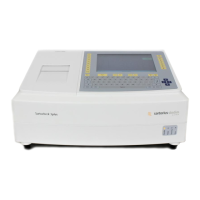12.1.3 Pressure Drop Test
The Pressure Drop Test is based
on the change in pressure within a
filter system connected upstream.
This change is caused by the diffu-
sive gas stream flowing through
a wet membrane at a given test
pressure (see “Diffusion Test”).
The pressure drop measured in
the process can be directly used as
the measure of the filter sys-
tem’s integrity, provided that the
upstream volume of the system
is constant and known.
At the same diffusion rate, lower
pressure drops are yielded for larger
upstream volumes, and higher
pressure drops for smaller upstream
volumes.
For this reason, a Pressure Drop
Test is recommended mainly to
leak-test empty housings and pres-
sure vessels with a known volume.
This is also obtained by using the
following simplified equation for
calculating the pressure drop from
the diffusion, test time, upstream
volume and p
0
.
D · t · P
0
–––––––––––– = ∆p
V
N
∆p = Pressure drop in mbar
within test time “t”
D = Gas diffusion in ml/min
t = Test time in min
P
0
= 1000 mbar or barometric
pressure in mbar depending
on setting
V
N
= Upstream volume of the
system in ml.
For this reason, a Pressure Drop
Test is recommended mainly to
leak-test empty housings and
pressure vessels with a known
volume.
51
12.1.4 Water Intrusion Test|
Water Flow Test
This test method has been spe-
cially developed for the testing of
hydrophobic air filter candles. The
principle of the test sequence cor-
responds to the diffusion test. The
difference is that the hydrophobic
filter element or the filter housing
must be flooded with water before
the actual testing. In this way, duri-
ng the pressurization of the system,
by measuring the pressure drop that
occurs in the housing during the
test period, the volume of water
that penetrates into the hydropho-
bic filter matrix (water intrusion)
can be calculated.
The water intrusion test is suitable
for all hydrophobic systems with
a filter surface from approx.
1000 cm
2
. The water intrusion
is calculated according to the
following equation by means of
the measured pressure drop with
consideration of the net volume
and the test time:
∆p
(
∆t
)
· V
N
I = ––––––––––––– [ m l / t ]
P
O
P
0
= Standard reference pressure
(1000 mbar)
∆p
(
∆t
)
= is the pressure drop volume
of the printout protocol
V
N
= System net volume ml
The water flow value is calculated
according to the following equation
by means of the measured pressure
drop with consideration of the net
volume and the test time:
∆p
(
∆t
)
· V
N
W F = ––––––––––––– [ m l / t ]
P
als.
– ∆p

